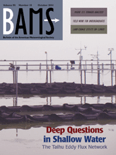
BULLETIN OF THE AMERICAN METEOROLOGICAL SOCIETY
Scope & Guideline
Advancing meteorological knowledge for a sustainable future.
Introduction
Aims and Scopes
- Meteorological Research and Forecasting:
Focuses on the development and improvement of weather prediction models, numerical weather prediction techniques, and observational methodologies to enhance forecasting accuracy. - Climate Change Impacts and Adaptation:
Explores the effects of climate change on weather patterns, ecosystems, and human activities, emphasizing strategies for adaptation and resilience in various sectors. - Atmospheric Processes and Phenomena:
Investigates atmospheric dynamics, including the study of severe weather events such as hurricanes, tornadoes, and extreme precipitation, to improve understanding and prediction. - Interdisciplinary Collaboration and Communication:
Promotes partnerships between meteorologists, social scientists, and stakeholders to enhance the societal relevance of weather and climate services, emphasizing effective communication strategies. - Aerosol and Air Quality Research:
Examines the interactions between aerosols, clouds, and climate, and their implications for air quality and public health. - Education and Training:
Addresses the importance of education and training in meteorology and atmospheric sciences, fostering the development of the next generation of scientists.
Trending and Emerging
- Artificial Intelligence and Machine Learning in Meteorology:
There is a growing trend towards utilizing AI and machine learning techniques for weather prediction, data analysis, and improving forecasting systems. - Climate Resilience and Adaptation Strategies:
Increased emphasis on developing actionable strategies for climate resilience and adaptation in various sectors, particularly in response to extreme weather events and climate change impacts. - Community Engagement and Stakeholder Collaboration:
Emerging focus on co-producing knowledge with stakeholders to enhance the applicability and effectiveness of weather and climate services. - Integrated Earth System Science:
A trend towards interdisciplinary research that integrates atmospheric sciences with other Earth system components, including oceanography and land surface processes. - Real-Time Data Utilization and Monitoring:
Growing interest in the use of real-time data for monitoring weather phenomena and informing decision-making processes in emergency management and public safety.
Declining or Waning
- Traditional Weather Prediction Techniques:
There has been a noticeable decline in publications focused solely on traditional weather prediction methods, as newer technologies and machine learning approaches gain prominence. - Historical Weather Events Analysis:
Research centered on historical weather events, while still relevant, has seen a reduction in frequency, possibly overshadowed by more contemporary and predictive studies. - Static Climate Models:
The reliance on static climate models has diminished as researchers increasingly adopt dynamic and integrated approaches that consider real-time data and scenario modeling.
Similar Journals
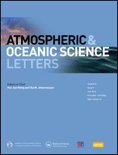
Atmospheric and Oceanic Science Letters
Pioneering Open Access Research in Atmospheric and Oceanic ScienceAtmospheric and Oceanic Science Letters is a premier open-access journal dedicated to the rapidly evolving fields of atmospheric science and oceanography. Published by KEAI PUBLISHING LTD, this journal aims to foster research dissemination and collaboration by providing a platform for high-quality research articles, reviews, and case studies that address critical issues impacting atmospheric and oceanic systems. With an impressive impact factor reflecting its esteemed position—including being ranked Q2 in Atmospheric Science and Q1 in Oceanography in 2023—this journal is an essential resource for researchers, professionals, and students alike. The journal's Open Access model, adopted since 2016, ensures that groundbreaking research is readily available to a global audience, enhancing knowledge transfer and facilitating innovative solutions to environmental challenges. Operating out of the United Kingdom and reaching an international readership, Atmospheric and Oceanic Science Letters plays a pivotal role in shaping our understanding of the interactions between the atmosphere and oceans, making it a vital publication for anyone aiming to stay at the forefront of these dynamic scientific fields.
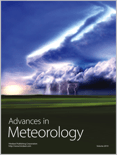
Advances in Meteorology
Transforming Weather Insights into Actionable KnowledgeAdvances in Meteorology is a renowned open-access journal published by Hindawi Ltd, dedicated to the dynamic field of meteorology and related atmospheric sciences. Since its inception in 2009, this journal has served as a vital platform for researchers and professionals, facilitating the dissemination of cutting-edge research that advances our understanding of atmospheric phenomena. With a commendable impact in the realms of Geophysics, Atmospheric Science, and Environmental Pollution, it boasts impressive Scopus rankings—34th percentile in Geophysics, 54th in Atmospheric Science, and 61st in Environmental Pollution—highlighting its significance and relevance in these critical areas. The journal's commitment to open access ensures that vital research reaches a wide audience, fostering collaboration and innovation within the scientific community. Positioned with a mix of rigorous research and interdisciplinary approaches, Advances in Meteorology continues to shape the landscape of atmospheric science research from its base in Egypt, addressing pressing global challenges related to climate and environment.

Atmosphere
Innovating Research for a Sustainable FutureAtmosphere is a premier open-access journal dedicated to the field of atmospheric sciences, published by MDPI since 2010. With an E-ISSN of 2073-4433, the journal has established itself as a significant platform for the dissemination of research on atmospheric processes, climate change, and environmental dynamics. Based in Switzerland, the journal has garnered impressive recognition within the academic community, currently ranked in the 3rd quartile for Atmospheric Science and the 2nd quartile for Environmental Science (miscellaneous) as of 2023. Notably, it holds a commendable Scopus rank, emphasizing its impact with a 69th percentile standing in its category. Atmosphere aims to foster innovative research and comprehensive reviews that contribute to the understanding of air quality, climate policy, and environmental sustainability. Its open-access model not only supports the global sharing of knowledge but also enhances visibility and engagement among researchers, professionals, and students alike, making it an essential resource for anyone invested in the study of our planet's atmosphere.
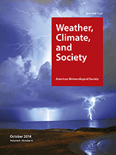
Weather Climate and Society
Connecting Climate Change with Human BehaviorWeather Climate and Society, published by the American Meteorological Society, serves as a leading journal in the interdisciplinary intersection of atmospheric sciences and social sciences. With an ISSN of 1948-8327 and an E-ISSN of 1948-8335, this journal emphasizes the impacts of weather and climate on societal dynamics. Since its inception in 2009, it has gained recognition for its scholarly contributions, achieving a respectable Q3 ranking in Atmospheric Science and Global and Planetary Change, and a notable Q2 ranking in Social Sciences (miscellaneous) as of 2023. Located in the heart of Boston, Massachusetts, the journal is committed to fostering a comprehensive understanding of how climatic factors influence human behavior and decision-making. With access options available for researchers and institutions, Weather Climate and Society is an essential resource for academics and professionals dedicated to exploring the critical interplay between weather, climate, and societal frameworks.
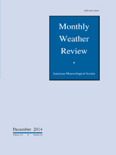
MONTHLY WEATHER REVIEW
Fostering Innovation in Meteorological ResearchMONTHLY WEATHER REVIEW, published by the American Meteorological Society, is a leading journal in the field of atmospheric science, recognized for its rigorous peer-reviewed articles that contribute significantly to the understanding of weather patterns and climate systems. With an impressive Q1 ranking in the 2023 category quartiles and a strong standing (#41 out of 148) in the Earth and Planetary Sciences Scopus rankings, the journal serves as an essential resource for researchers, professionals, and students alike. Although it does not currently offer open access, its comprehensive coverage of meteorological research spanning from 1960 to 2024 makes it invaluable for those seeking to stay at the forefront of developments in weather analysis and prediction. Situated in Boston, Massachusetts, this journal not only showcases pioneering research but also emphasizes the importance of collaborative efforts in the meteorological community, ultimately contributing to advancements in our understanding of atmospheric phenomena.
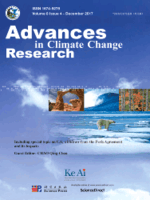
Advances in Climate Change Research
Advancing Knowledge for a Sustainable FutureAdvances in Climate Change Research is a premier open-access journal dedicated to advancing the understanding of climate change and its wide-ranging impacts on our planet. Published by KEAI PUBLISHING LTD since 2010, it has established itself as a leading forum for research in Atmospheric Science, Global and Planetary Change, and Environmental Management, achieving a notable Q1 ranking across these categories as of 2023. The journal, which operates out of Beijing, China, ensures that researchers, professionals, and students have unrestricted access to cutting-edge studies, enhancing global knowledge on climate change mitigation and policy development. With impressive Scopus rankings, including 11th out of 148 in Atmospheric Science, it represents a vital resource for those seeking to contribute to climate science and its applications. By submitting your work to this influential journal, you join a global community committed to addressing one of the most pressing challenges of our time.

ADVANCES IN ATMOSPHERIC SCIENCES
Connecting Scholars to Address Atmospheric ChallengesADVANCES IN ATMOSPHERIC SCIENCES is a highly esteemed journal published by SCIENCE PRESS, dedicated to advancing the field of atmospheric sciences. With an impressive impact factor and ranking as Q1 in Atmospheric Science as of 2023, this journal serves as a leading platform for researchers, professionals, and students to disseminate substantial findings and innovative methodologies across various topics within the atmospheric sciences domain. Established in 1984 and continuously publishing through to 2024, it has successfully positioned itself among the top ranks, currently standing at #17 out of 148 in the Scopus category, highlighting its significance in the field with a remarkable 88th percentile. Although it operates under traditional access, the journal provides invaluable insights into climate dynamics, meteorology, and environmental processes that are crucial for both academic and practical applications. Based in Beijing, China, ADVANCES IN ATMOSPHERIC SCIENCES is committed to fostering a global dialogue and collaboration among scholars and industry experts, making it an essential resource for those invested in understanding and addressing contemporary atmospheric challenges.

Asia-Pacific Journal of Atmospheric Sciences
Championing Open Access to Groundbreaking ResearchWelcome to the Asia-Pacific Journal of Atmospheric Sciences, a leading publication in the field of atmospheric science, published by the Korean Meteorological Society. With an ISSN of 1976-7633 and an E-ISSN of 1976-7951, this journal has been a cornerstone for researchers and practitioners in the atmospheric sciences since its inception in 2008. Recognized for its rigorous peer-reviewed articles, it holds a commendable Q2 quartile ranking in 2023 and is placed at the 51st rank out of 148 in the Earth and Planetary Sciences, reflecting its impact within the community with a 65th percentile. The journal features a broad scope encompassing meteorology, climatology, and environmental sciences, making it an essential resource for scholars and industry experts alike. As an open access journal, it ensures that groundbreaking research is widely accessible, fostering collaboration and innovation across the Asia-Pacific region and beyond. Explore the latest findings and advancements in atmospheric sciences and contribute to the dynamic field of climate research through the journal's engaging content.

Tethys-Journal of Mediterranean Meteorology & Climatology
Advancing Knowledge of Mediterranean Weather PatternsTethys - Journal of Mediterranean Meteorology & Climatology, published by the Associació Catalana de Meteorologia (ACAM), serves as a specialized platform dedicated to advancing the study of meteorological and climatological phenomena within the Mediterranean region. With a Scopus Rank of #94 out of 148 in the field of Atmospheric Science, this journal is positioned in the Q4 category, reflecting a growing recognition among researchers focused on regional climate variations and environmental challenges. Established in 2012 and publishing through 2023, Tethys aims to provide open access to high-quality research articles that address critical issues impacting climate and weather patterns, thus contributing to a deeper understanding of Mediterranean meteorology. The journal’s mission aligns closely with the increasing global emphasis on climate studies and serves as an essential resource for academics, practitioners, and students dedicated to sustainably addressing the environmental and climatic challenges faced by this diverse and dynamic region.

Atmosphere-Korea
Fostering Understanding of Climate Impacts on SocietyAtmosphere-Korea is a prestigious journal published by the Korean Meteorological Society, dedicated to advancing the field of atmospheric sciences. With a focus on both theoretical and applied research, this journal encompasses a wide range of topics including meteorology, climatology, and environmental science, providing a platform for researchers to disseminate their findings and enhance scientific dialogue. Although currently not categorized under an open access model, the journal ensures that all articles meet rigorous scientific standards, thereby maintaining its credibility and academic integrity. The ISSN 1598-3560 and E-ISSN 2288-3266 identify its unique contributions to global knowledge in meteorology. Researchers, professionals, and students alike benefit from the invaluable insights offered through its publications, making Atmosphere-Korea an essential resource in understanding climatic phenomena and their implications for society.